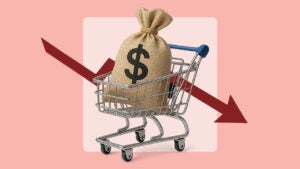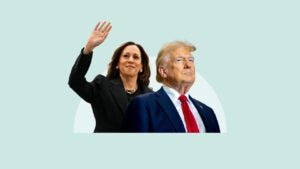Survey: 69% of Americans are worried about a possible recession by the end of 2023

At a time when the U.S. economy is clearly slowing and inflation remains troublingly high, a new Bankrate poll suggests concerns about the economic outlook are top of mind for Americans.
Nearly 7 in 10 Americans (69 percent) say they’re worried about the possibility of a recession before the end of next year, with 29 percent saying they’re very worried and another 40 percent saying they’re somewhat worried.
At the same time, more than 2 in 5 (41 percent) in Bankrate’s poll feel they would be unprepared to handle a downturn if one were to begin before the end of next year. But in a positive sign, the majority of Americans (74 percent) say they’re actively taking steps to prepare for an economic downturn.
These findings accompany July data from the Department of Commerce showing the financial system shrank for two straight quarters, qualifying as what’s long been considered the technical rule-of-thumb of a recession. Economists, however, are raising their eyebrows at that distinction amid the strongest job market in half a century — though that’s not to say Americans aren’t already feeling like they’re living through a downturn during one of the biggest hits to their purchasing power in four decades.
“While some Americans indicate they believe the economy is already in a recession, it is perhaps more important that so many are already taking actions based on their fears or beliefs that one is inevitable over the next year or so,” says Mark Hamrick, Bankrate senior economic analyst and Washington bureau chief.
Key takeaways:
- Majority of Americans (at 69 percent) are worried about the possibility of a recession before the end of next year.
- More than two-fifths of Americans (41 percent) do not feel they would be prepared for a recession if it were to happen by the end of next year, with 17 percent feeling they are not at all prepared.
- Women, minorities and lower earners are more likely to feel unprepared for a recession by the end of 2023.
- Nearly 3 in 4 Americans (74 percent) are taking steps to prepare for a recession, with the top preparation between cutting discretionary spending (47 percent), saving more for emergencies (35 percent) and paying down credit card debt (30 percent).
- More than half of adults (51 percent) say inflation will be higher a year from now than it is now.
Majority of Americans are worried about a recession by 2023
A much smaller group of Americans say they’re not worried about the possibility of a recession by the end of next year, at nearly 1 in 3 (31 percent). That includes 21 percent who say they’re not too worried, along with another 9 percent who say they’re not at all worried.
How prepared Americans say they are for a recession is a big reason why they may or may not be worried. Nearly half (47 percent) of individuals who say they’re very prepared for a recession are not worried about the possibility of a downturn. That compares with 75 percent of individuals who say they’re not prepared and are worried about a downturn.
Meanwhile, women were more likely than men (at 74 percent versus 65 percent, respectively) to worry about a possible upcoming recession. Millennials and Generation X (at 73 percent and 72 percent) were also more likely to worry than their Generation Z and baby boomer counterparts, at 66 percent and 67 percent, respectively.
More than 2 in 5 would not be prepared for a recession by the end of next year
A strong signal for Americans’ ability to weather a recession, the majority (59 percent) of Americans say they would be prepared to handle a recession if it were to begin before the end of next year, with 42 percent saying they’re somewhat prepared and 17 percent saying they’re very prepared.
Almost a quarter (24 percent) say they would be not too prepared for a downturn, while 17 percent say they’re not at all prepared.
Women, minorities and lower earners are more likely to feel unprepared for an upcoming recession
But there were crucial disparities in who considered themselves to be prepared and who did not — likely highlighting long-run gender, racial and economic divides that are only exacerbated in economic downturns.
Almost half (46 percent) of Black and Hispanic Americans say they would not be prepared for a downturn, should one strike before the end of 2023 — compared with 38 percent of White Americans. Women, meanwhile, are more likely than men to say they’re not at all prepared, at 20 percent versus 14 percent.
How much money you earn is another major factor inhibiting people from feeling prepared for a downturn. More than half (53 percent) of those who make less than $50,000 annually say they don’t feel ready for a downturn, compared with:
- 32 percent of those earning between $50,000 and $79,999;
- 21 percent of those earning between $80,000 and $99,999; and
- 24 percent making $100,000 or more.
Education gaps could also be part of the picture. A respective 30 percent and 28 percent of those with a four-year or post-graduate degree cite being unready for a year-end 2023 recession, compared with 46 percent of those with a high school diploma or less.
“Because not all Americans have the same level of financial resources or security, the impacts can differ wildly depending on that condition before the downturn,” Hamrick says. “For those living on the financial edge, the prospect or reality of job loss can be devastating. As many Americans live paycheck-to-paycheck, when an interruption in employment or income occurs, they may enter a very precarious situation, with worst-case scenarios being homelessness or food insecurity or hunger.”
Nearly 3 in 4 are taking steps to prepare for a recession
The best time to prepare for a recession is often before it even begins — and only 26 percent of Americans say they’re not taking steps to get their finances ready for a downturn.
The most common steps to prepare for a recession include:
- Spending less on discretionary purchases, at 47 percent;
- Saving more for emergencies, at 35 percent;
- Paying down credit card debt, at 30 percent;
- Looking for additional or more stable income, at 24 percent; and
- Saving more for retirement, at 19 percent;
A smaller share, at 4 percent, cited doing something else.
Younger Americans were more likely to look for additional income, at 36 percent for both Gen Z and millennials compared with 24 percent of Gen X and 11 percent of boomers. Considering the continued strength of the job market, that search is more likely to prove successful. Joblessness hasn’t been this low since the 1960s, while employers in June had close to 11 million job openings.
Perhaps the most challenging for Americans’ wallets, 31 percent of those who consider themselves unprepared for a recession are currently doing nothing to prepare. Meanwhile, 42 percent of those who say they’re not at all prepared aren’t taking any financial steps. That compares with 22 percent of those who consider themselves prepared and say they’re taking no action.
More than half say inflation will be higher a year from now than it is now
Another complex layer posing challenges for the broader economic landscape, more than half (51 percent) of Americans expect inflation will be higher a year from now. More than 1 in 5 (22 percent) say it will be much higher, while 28 percent say it will be somewhat higher.
Just 16 percent of Americans expect inflation will be lower a year from now.
Those beliefs could put the Federal Reserve in a tight spot, which largely sees price pressures as basic psychology. Simply put, Americans who expect inflation will be higher a year from now will behave as such, possibly asking their employers for a raise or following through on their big-ticket purchases even earlier than their initial plans.
Officials in 2022 are hiking interest rates at the fastest pace in decades, with no plans to slow down until inflation looks like it has meaningfully cooled. Hotter inflation for longer raises the risk of the Fed tightening even more than the financial system can handle, possibly bringing forth the very recession Americans have been fearing.
One Catch-22: a substantial portion of Americans saying they’re planning to spend less on discretionary purchases could take some pressure off inflation — but it could also pose consequences for a consumer-driven economy, considering that spending powers businesses’ ability to keep hiring and producing.
Taking steps to prepare your wallet for a downturn are more important now than ever, with the U.S. economy facing several crucial inflection points in the year ahead.
“The Fed led by Chairman Jerome Powell has more work to do to battle high prices as well as to restore their credibility as inflation fighters,” Hamrick says. “With about half of consumers saying they’re cutting back on discretionary purchases, that alone weighs on economic activity, making a contraction more likely.”
Methodology
Bankrate.com commissioned YouGov Plc to conduct the survey. All figures, unless otherwise stated, are from YouGov Plc. The total sample size was 2,390 adults. Fieldwork was undertaken between July 27-29, 2022. The survey was carried out online and meets rigorous quality standards. It employed a nonprobability-based sample using quotas upfront during collection and then a weighting scheme on the back end designed and proven to provide nationally representative results.
Why we ask for feedback Your feedback helps us improve our content and services. It takes less than a minute to complete.
Your responses are anonymous and will only be used for improving our website.






